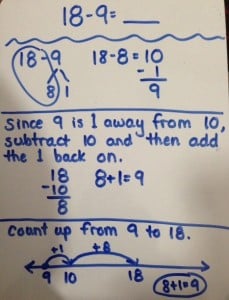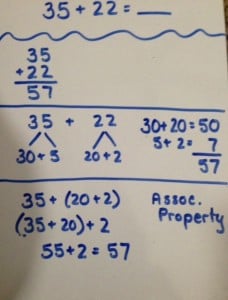by Cindy Elkins, OK Math and Reading Lady
For 1st -3rd grade students: Refer to “Number Talks Part I” (posted Nov. 12, 2016) for ways to conduct a Number Talk with KG and early 1st grade students (focusing on subitizing and number bonds). For students in 1st – 3rd grade, place extra emphasis on number bonds of 10.
- Problem: 8 + 6
- Problem: 15 + 9
- Problem: 18 – 9
- Problem: 35 + 22
- Problem: 99 + 6
- Problem: 200 – 48
Write a problem on the board, easel, or chart tablet with students sitting nearby to allow for focused discussion. Have the following available for reference and support: ten frame, part-part-whole template, base ten manipulatives, and a 0-100 chart. Present addition and subtraction problems to assist with recall of the following strategies. If time allows, post another similar problem so students can relate previous strategy to new problem. Students show thumbs up when they have an answer in mind. The teacher checks with a few on their answer. Then he/she asks, “How did you solve this problem?” The teacher writes how each student solved the problem.
- Reference these videos on youtube.com for examples by clicking on the link:
- First grade Number Talks: Showing problems 7 + 3, 7 + 3 + 5, and 3 + 5 + 7
- Second grade Number Talks: Showing problem 16 + 15
Here are some strategies to work on with 1st – 3rd graders.
- Doubles (such as 5 + 5)
- Near doubles: To help me solve 5 + 6, I can use what I know about doubles (5 + 5 + 1) or (6 + 6 – 1).
- Making a ten: To add 8 + 6, I can take 2 from the 6 and put it with the 8 to make 10 and 4. This is why number bonds of 10 are so important.
- 1 more, 1 less: Show problems such as: 8 + 1, 51 + 1, and 6 – 1, 22-1
- 10 more, 10 less: Show problems such as 4 + 10, 24 + 10, and 15-10, 83-10
- Counting up to add: For 9 + 3, I start at 9 and count up 3 more.
- Counting up or back to subtract: For 12 – 9, I start at 12 and count back 9. Or I can count up from 9 to 12.
- Part-part-whole: Same concept as number bonds, but really helpful for subtraction. If I have 10 and subtract part of it (3), what is the other part that’s left? (7)
- Place value Decomposition: 35 + 22 can be decomposed into tens and ones 30+20 added to 5+2. Or 35 – 22 can be decomposed to 30-20 plus 5-2.
- Base Ten: Use actual base ten pieces or pictorial representation such as sticks for tens and dots for ones.
- Compensation: Adjusting one or more numbers to make them easier to add or subtract. Example for addition: 99 + 6. Take 1 from the 6 and give to the 99 to make the problem 100 + 5. Example for subtraction: 200 – 48. Subtract 1 from each part to show the new problem as 199 – 47, which involves NO regrouping. This is justified because subtraction involves finding the difference between two numbers. Picture what this looks like on a number line. The difference was adjusted by 1 for each number.
- Open number line: This uses the strategies of counting up or back to add or subtract along with knowledge of number bonds and place value. I will focus on this strategy in more detail on a future post.
After experience with Number Talks, students can also show their thinking in written form first before bringing it to a class discussion. This can be done as a “ticket in the door” or “bell work” while getting settled for the day, taking attendance, lunch count, etc. or after recess as a calm down thinking activity. Use Choose 3 Ways as a template idea (click for blank copy). Here are some examples:
- Probem: 74 – 38
Have you tried to conduct a Number Talk session? Watch the videos (above) and or use the Number Talk book (see previous post or Resource section). Let us know how it goes.
Watch for Part 3: Number Talks for 3rd – 5th grade







